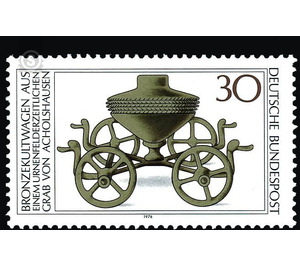Archaeological Heritage (1) - Germany / Federal Republic of Germany 1976 - 30 Pfennig
Theme: Art & Culture
| Country | Germany / Federal Republic of Germany |
| Issue Date | 1976 |
| Face Value | 30.00 |
| Color | brown white |
| Perforation | K 14 |
| Printing Type | Multicolor offset printing |
| Stamp Type | Postage stamp |
| Item Type | Stamp |
| Chronological Issue Number | 786 |
| Chronological Chapter | GER-BRD |
| SID | 178496 |
| In 63 Wishlists | |
During earth excavation for a Aussiedlerhof in Acholshausen, district Ochsenfurt, 1970 discovered the grave of a man from the Urnfield period (around 1000 BC), the equipment, weapons and jewelry made of bronze, 38 clay vessels, including cups, cups, bowls and pots and, as the most significant addition, contained a small bronze cult car. The finds are exhibited in the Mainfränkisches Museum in Würzburg. The car consists of a cruciform frame with axles, which ends in front and behind in two finely curved heads of waterfowl - perhaps ducks. Small four-spoke wheels are attached to the axle ends. Firmly riveted to the frame, in the middle of a small solid cast kettle, which is decorated with slanted ribs, Tannenzweigmustergefüllten ribbons and horizontal grooves, which in turn are framed on top and bottom by a frieze of semicircular arches. The car is about 18 cm long and 12 cm high.


